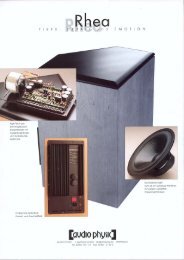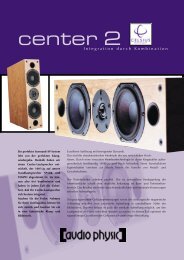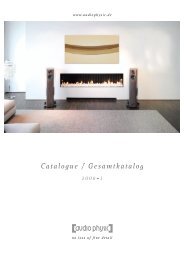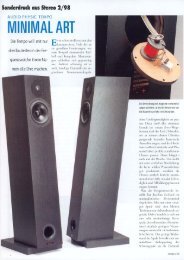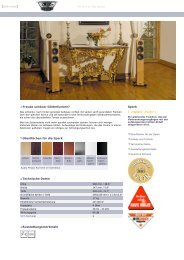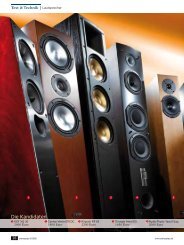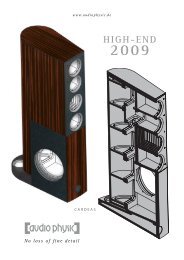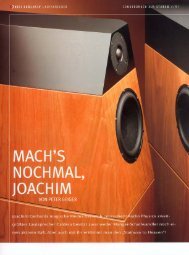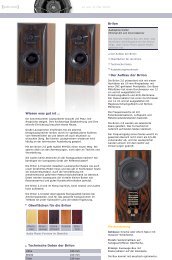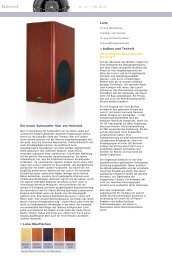Audio Physic Scorpio Loudspeakers
Audio Physic Scorpio Loudspeakers
Audio Physic Scorpio Loudspeakers
Create successful ePaper yourself
Turn your PDF publications into a flip-book with our unique Google optimized e-Paper software.
and folk music, Danny has a feel for the bass that<br />
simultaneously encompasses all three disciplines, which is<br />
just one reason why he is the dean of British bass players.<br />
Anyway, they open this track with a duet that adds<br />
Richard’s vocal and slowly brings in Michael Jerome’s<br />
drums. The song — a meditation on finding love late in life,<br />
but at least finally finding it — moves in a dignified, at times<br />
floating procession that is suspended by the subtle bass<br />
line that plays hide and seek with the tom-toms. However,<br />
as good as the lyrics are, the heart of the song lies in the<br />
last two and half minutes where all three players probe the<br />
lessons of time. With the <strong>Scorpio</strong>s, the details of this<br />
interplay were vivid, with deep, smooth, even and powerful<br />
bass. Though not a wall-buster, the bass filled the room<br />
with tonally correct, taut rhythm.<br />
Up top, this track also showed the skill of the soft-dome<br />
tweeter. Jerome plays some exquisite cymbals, sneaking<br />
into the song with a soft spray of stickwork before gradually<br />
working in the rest of his kit. I have a small drum kit in the<br />
basement (don’t ask) and when no one is around sneak<br />
down there to make an unholy racket. Anyway, getting that<br />
soft spray sound spot on is about as hard a task as any<br />
tweeter can attempt. The leading edge must be an<br />
instantaneous jump while never veering into harshness,<br />
while the trailing edge needs to offer an almost insane<br />
amount of subtle detail. <strong>Audio</strong> <strong>Physic</strong> accomplished both<br />
with a skill that was a near perfect mirror of the sound I<br />
hear in basement.<br />
For staging I turned to an old favorite Te Deum by Arvo<br />
Pärt [ECM 1505]. Recorded in Lohjan Kirkko, the third<br />
largest stone church in Finland, the building is a simple but<br />
gorgeous, gothic masterpiece, complete with murals and a<br />
wooden belfry. Completed approximately 1480, it features<br />
high walls to reflect and extend decay with numerous<br />
internal arches to diffuse the sound. The resonant walls<br />
give the recording a warm glow, highlighting, especially,<br />
the wonderful female voices in the 28-member Estonian<br />
Philharmonic Chamber Choir. To top it off, the album<br />
includes several pictures from the recording sessions,<br />
allowing you to actually see the staging before trying to<br />
aurally decode the same information. With the <strong>Audio</strong><br />
<strong>Physic</strong> loudspeakers the singers — moving left to right<br />
from soprano to bass — were physically spread and easy<br />
to pinpoint even as the hall effect granted a resplendent<br />
halo over the proceedings. The Tallinn Chamber Orchestra<br />
with prepared piano hard right, violins hard left and basses,<br />
cellos and violas in the center, were likewise arrayed in an<br />
easy to follow manner, helping to create the illusion of<br />
attending a live performance.<br />
Dynamically, in my room the <strong>Scorpio</strong>s showed very well,<br />
with a clean, explosive but never biting leading edge. While



